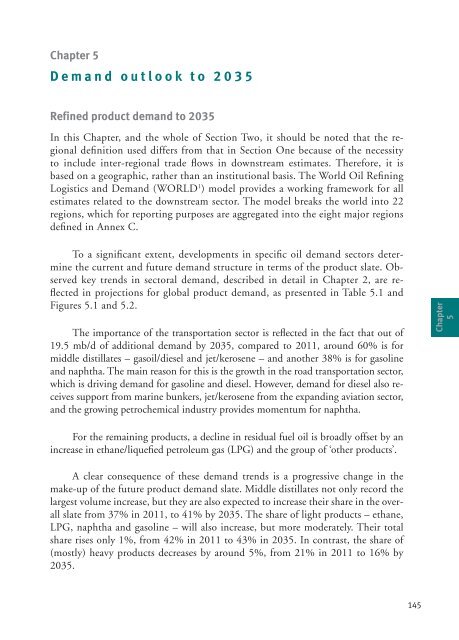World Oil Outlook - Opec
World Oil Outlook - Opec
World Oil Outlook - Opec
- TAGS
- world
- outlook
- opec
- www.opec.org
Create successful ePaper yourself
Turn your PDF publications into a flip-book with our unique Google optimized e-Paper software.
Chapter 5<br />
Demand outlook to 2035<br />
Refined product demand to 2035<br />
In this Chapter, and the whole of Section Two, it should be noted that the regional<br />
definition used differs from that in Section One because of the necessity<br />
to include inter-regional trade flows in downstream estimates. Therefore, it is<br />
based on a geographic, rather than an institutional basis. The <strong>World</strong> <strong>Oil</strong> Refining<br />
Logistics and Demand (WORLD 1 ) model provides a working framework for all<br />
estimates related to the downstream sector. The model breaks the world into 22<br />
regions, which for reporting purposes are aggregated into the eight major regions<br />
defined in Annex C.<br />
To a significant extent, developments in specific oil demand sectors determine<br />
the current and future demand structure in terms of the product slate. Observed<br />
key trends in sectoral demand, described in detail in Chapter 2, are reflected<br />
in projections for global product demand, as presented in Table 5.1 and<br />
Figures 5.1 and 5.2.<br />
The importance of the transportation sector is reflected in the fact that out of<br />
19.5 mb/d of additional demand by 2035, compared to 2011, around 60% is for<br />
middle distillates – gasoil/diesel and jet/kerosene – and another 38% is for gasoline<br />
and naphtha. The main reason for this is the growth in the road transportation sector,<br />
which is driving demand for gasoline and diesel. However, demand for diesel also receives<br />
support from marine bunkers, jet/kerosene from the expanding aviation sector,<br />
and the growing petrochemical industry provides momentum for naphtha.<br />
For the remaining products, a decline in residual fuel oil is broadly offset by an<br />
increase in ethane/liquefied petroleum gas (LPG) and the group of ‘other products’.<br />
A clear consequence of these demand trends is a progressive change in the<br />
make-up of the future product demand slate. Middle distillates not only record the<br />
largest volume increase, but they are also expected to increase their share in the overall<br />
slate from 37% in 2011, to 41% by 2035. The share of light products – ethane,<br />
LPG, naphtha and gasoline – will also increase, but more moderately. Their total<br />
share rises only 1%, from 42% in 2011 to 43% in 2035. In contrast, the share of<br />
(mostly) heavy products decreases by around 5%, from 21% in 2011 to 16% by<br />
2035.<br />
145<br />
Chapter<br />
5
















